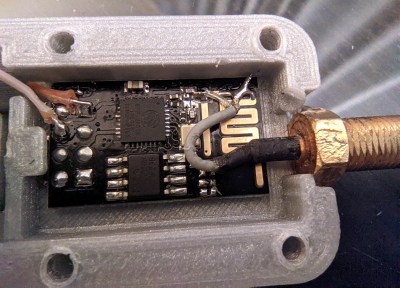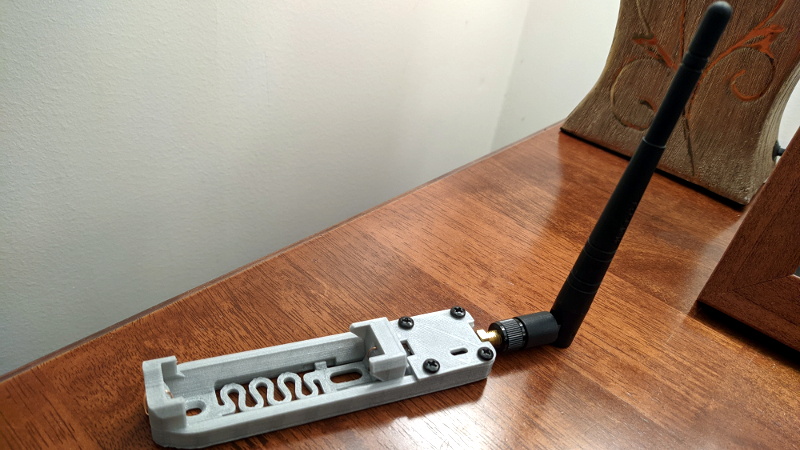We’re truly fortunate to have so many incredible open source projects floating around on the Internet, since there’s almost always some prior art you can lean on. By combining bits and pieces from different projects, you can often save yourself a huge amount of time and effort. It’s just a matter of figuring out how all the pieces fit together, like in this clever mash-up by [bethiboothi] that takes advantage of the fact that the popular TP4056 lithium-ion battery charger module happens to be almost the exact same size of the ESP-01.
 By taking a 3D printed design intended to attach a TP4056 module to the end of an 18650 cell and combining it with an ESP8266 firmware that turns the powerful microcontroller into a WiFi repeater, [bethiboothi] ended up with a portable network node that reportedly lasts up to three days on a charge. The observed range was good even with the built-in PCB antenna, but hacking on an external can get you out a little farther if you need it.
By taking a 3D printed design intended to attach a TP4056 module to the end of an 18650 cell and combining it with an ESP8266 firmware that turns the powerful microcontroller into a WiFi repeater, [bethiboothi] ended up with a portable network node that reportedly lasts up to three days on a charge. The observed range was good even with the built-in PCB antenna, but hacking on an external can get you out a little farther if you need it.
While it doesn’t appear that [bethiboothi] is using it currently, the esp_wifi_repeater firmware does have an automatic mesh mode which seems like it would be a fantastic fit for this design. Putting together an impromptu mesh WiFi network with a bunch of cheap battery powered nodes would be an excellent way to get network connectivity at an outdoor hacker camp, assuming the ESP’s CPU can keep up with the demand.
















If you wanted to implement this as a “throwie” to leave a breadcrumb trail of repeaters you weren’t sure you were going to get back again, you might want a cheaper battery. It came to my attention that disposable vape pens actually have Lithium rechargeable in. Ergo, you might ask around, advertise, place a drop box etc to collect dead ones and repurpose the batteries.
In such a case, you maybe just want a stiff wire antenna cut to right length rather than the one shown also.
Vape pen batteries are tiny though. ~6cm x ~7mm. You’d only get wifi for an hour or 2 before they’d die. (I used to harvest them, but they’re of limited use)
The bigger ones are around an amp hour, that’s a day’s worth maybe. 250mAh ones probably not worth bothering with for this.
Could tie a few together to up your capacity. If you are getting them free from people who would be throwing them out otherwise that is.
…. lol, extending the visitors center wifi out the length of a hiking trail and picking them back up as you hike back.
“disposable vape pen”
Well this skind of evilish thing doesn’t even surprise me…
This is a very interesting concept as these things are essentially $1 each! I wonder what the possible bandwidth is. Can’t be much more than a couple single digit mbits, right?
About 5Mbit.
https://github.com/martin-ger/esp_wifi_repeater
It’s cool project to DIY, but you can get nice ESP8266 board with 18650 holder, charging circuitry and USB port (for programming) for $4 on AliExpress. Also you probably don’t want to use 4800mAh 18650 cells as they’re guaranteed fakes.
Link to board : https://www.aliexpress.com/item/1005001975423365.html
Wow, so your telling me if I paid more money for a commercial version it might have more features? Crazy stuff.
It is really more money? What’s your hourly rate for soldering?
If it takes you an hour to solder two wires to an ESP, I’m not sure what to tell you.
How about “$30 an hour”?
On the other hand, not everyone has the visual acuity or the fine motor skills to make those joints reliably.
I have taken to using a wire-wrap tool to connect (reversibly) to these development modules when I’m not using a breadboard.
Author’s estimate says “Build cost 8 dollars”, you get more features for less money in commercial version.
That includes the battery, which you would have to buy in either event. An ESP-01 is less than $2, and filament is literally pennies.
Neat, I would buy if I needed a handful (and source the batteries locally.)
For my own experiments I will make my own.
Now this I like. Add in a solar charger, and you have a repeater to get wifi down to the end of a long garden.
Leave a trail of these in ziplok bags (or even encapsulated in resin), and you have communications from the depths of a cave/mine – or even access to a filesystem running from the 12V battery of a car.
The possibilities are almost endless.
http://f3.to/cellsol/ This uses an esp32 but please do crib as needed
I’d have to get WiFi beyond my house’s steel siding first!
B^(
Had the same problem, ended up going up and over the siding through the roof… Wifi access points in the attic
Weekend project: take apart that Harbor Freight solar garden light with a LiFePO4 cell and throw in an ESP-01. LIkely the ESP will pull more current than the cell can make, but maybe set it up to run only when it’s dark or on a schedule.
https://www.harborfreight.com/120-lumen-solar-motion-security-light-black-64736.html
Cool idea for repeating to other IoT devices – I presume its not hugely usable for general browsing etc?
YouTube works great. Very useable!
Ahh thats fantastic – thanks for the insight! I might give it a go!
That 5g energy harvest tech with this could lead to a real sub-internet in a city… Hmm
Haha.
Worker: hey boss rf transmission is sagging.
Boss: turn up the rf wattage!!
Oh boy.
Don’t you have be basically be directly next to the tower for this to work?
My most recent project is powered by a 18650 from a solar motion sensing light… You can get them on aliexpress for ~50¢ each, comes with a small solar panel, 18650, a case and a bunch of leds… Along with their board that might have a moron sensor worth harvesting…
Add an esp01 and an antenna for a buck or so and you’ve got a ~$2 system that is capable of solar recharging…
Build a bunch of them and add in a few magnets slap them on the back of street signs and you’ve got WiFi all down the street.
is possible put B.A.T.M.A.N mesh ? repeater is not usefull but mesh network for disaster will be great
Looking at the soldering, it makes me think a better approach is to have a pcb made that can lay on top of the wifi so the connection points can touch. Thus not needing solder, the pcb’s just need to be pressed together. Just a thought…